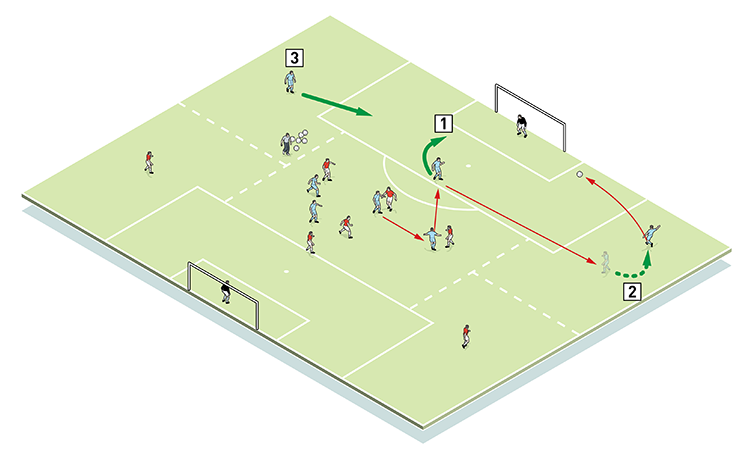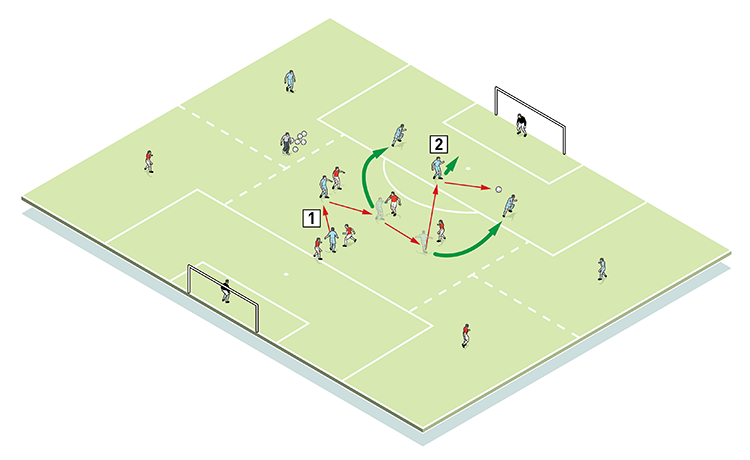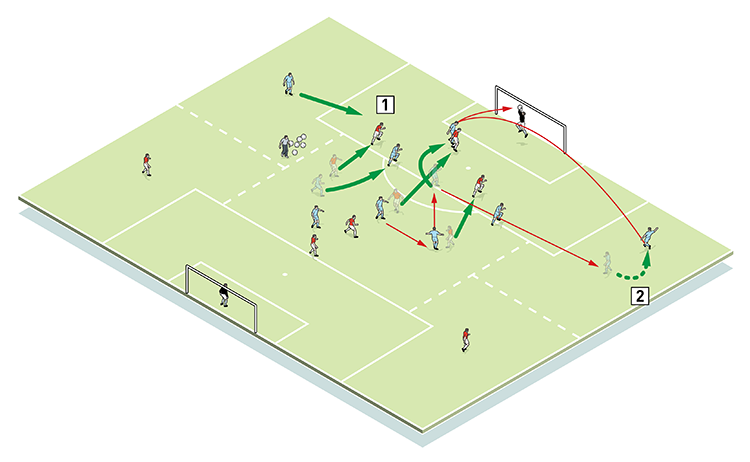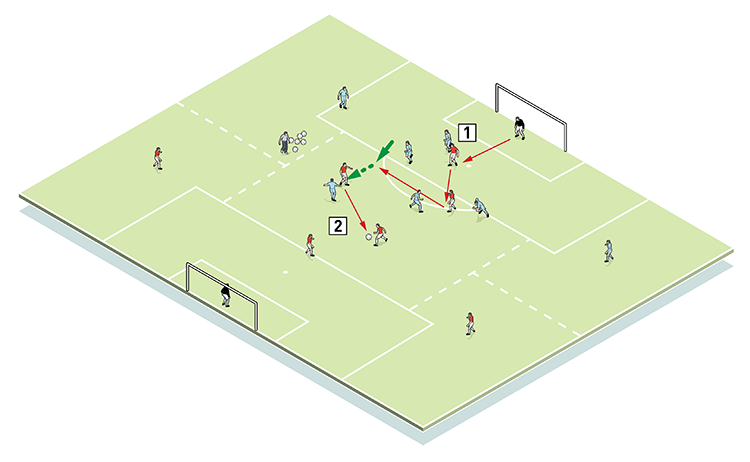




OUR BEST EVER OFFER - SAVE £100/$100
JOIN THE WORLD'S LEADING PROFESSIONAL DEVELOPMENT PROGRAMME
- 12 months membership of Elite Soccer
- Print copy of Elite Player & Coach Development
- Print copy of The Training Ground
You are viewing 1 of your 1 free articles
Crossing and finishing
| Area | Half a pitch |
| Equipment | Balls, cones, goals |
| No. of Players | 14 |
| Session Time | Session 10mins, progressions 10mins each |
Crossing and finishing is an inherent part of attacking play, and this quick-paced session addresses that by working on creation of space and movement in the box.
It’s also an important session for rehearsing the second phase of play, both for attackers and defenders.
What do I get the players to do?
The server plays the ball into the central area, to any player on the blue team. Blues have to make three passes before working the ball to their target player, who is positioned just inside the box. The ball is then fed wide to either of their two wingers (1). Blue players now make runs into the penalty area.
1

2. Possession is then fed out to the right winger
3. The left winger prepares to move into the box to support inrushing attackers
The winger in possession takes a touch to set up a cross. Blues break into the box with the focus being on good attacking movement. We’re looking for purposeful forward runs, with players taking up key attacking positions in the box, at near and far posts, in front of the keeper, and on edge of the box (ready for a second ball). The opposite winger can also enter from the other side and, with his team mates, attack the cross.
At the end of the attack – and whether a goal is scored or not - blues return to the central box. Now the server plays the ball in to the red team, who must repeat the task, attacking the opposite goal.
How do I progress the session?
To progress, we turn this into an opposed game, where teams have to make four passes before hitting the target player. The ball can then either go wide or stay central as attackers break into the box, looking to score (2).
2

2. This time the team abandons the flanks and concentrates the attack through the middle
In the second progression, defenders can now retreat in order to defend the cross (3a). If successful in protecting their goal, defenders can counter-attack quickly without the ball having to go back to the server (3b). So with blues having to retreat back to the central area, reds look to make four quick consecutive passes before attacking the other goal.
3a

2. A cross into the middle results in a header that’s saved
3b

2. Reds quickly aim to make four passes in the central box as blues retreat
What are the key things to look out for?
We’re looking for quick passing and intelligent movement into space. Precision of pass is equally important, with players being aware of transitions and the danger caused by any turnover of possession/
Related Files
Editor's Picks
Attacking transitions
Deep runs in the final third
Using the goalkeeper in build-up play
Intensive boxes drill with goals
Penetrating the final third
Creating and finishing
My philosophy
Pressing initiation
Compact team movement
Coaches' Testimonials

Alan Pardew

Arsène Wenger

Brendan Rodgers

Carlos Carvalhal

José Mourinho

Jürgen Klopp

Pep Guardiola

Roy Hodgson

Sir Alex Ferguson

Steven Gerrard
Coaches' Testimonials

Gerald Kearney, Downtown Las Vegas Soccer Club

Paul Butler, Florida, USA

Rick Shields, Springboro, USA

Tony Green, Pierrefonds Titans, Quebec, Canada
Join the world's leading coaches and managers and discover for yourself one of the best kept secrets in coaching. No other training tool on the planet is written or read by the calibre of names you’ll find in Elite Soccer.
In a recent survey 92% of subscribers said Elite Soccer makes them more confident, 89% said it makes them a more effective coach and 91% said it makes them more inspired.
Get Monthly Inspiration
All the latest techniques and approaches
Since 2010 Elite Soccer has given subscribers exclusive insight into the training ground practices of the world’s best coaches. Published in partnership with the League Managers Association we have unparalleled access to the leading lights in the English leagues, as well as a host of international managers.
Elite Soccer exclusively features sessions written by the coaches themselves. There are no observed sessions and no sessions “in the style of”, just first-hand advice delivered direct to you from the coach.







